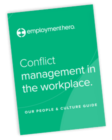Employee Suspension: What Employers Need to Know about Suspension from Work
Get the latest up to date ACAS advice and learn how you can handle employee suspensions fairly.

Get the latest up-to-date ACAS advice regarding suspension from work and learn how you can handle employee suspensions fairly.
Suspension. While it isn’t classed as a disciplinary action, the implications of someone getting suspended in your business can have a ripple effect that can impact your entire team. The decision to suspend an employee shouldn’t be taken lightly and any investigations must be carried out thoroughly while prioritising health and safety precautions.
Join us as we uncover what employee suspension is, and the steps you can take to make sure that the disciplinary matter is properly investigated from start to finish.
Disclaimer: The information in this blog is current as at 19th December 2024, and has been prepared by Employment Hero Pty Ltd (ABN 11 160 047 709) and its related bodies corporate (Employment Hero). The views expressed in this article are general information only, are provided in good faith to assist employers and their employees, and should not be relied on as professional advice. The Information is based on data supplied by third parties. While such data is believed to be accurate, it has not been independently verified and no warranties are given that it is complete, accurate, up to date or fit for the purpose for which it is required. Employment Hero does not accept responsibility for any inaccuracy in such data and is not liable for any loss or damages arising either directly or indirectly as a result of reliance on, use of or inability to use any information provided in this article. You should undertake your own research and to seek professional advice before making any decisions or relying on the information in this blog.
What is employee suspension?
ACAS describes a suspension from work as a situation where an employer tells an employee to stop carrying out work temporarily. The person in question will remain employed but will not engage in work or attend work premises.
So, why might an employee be suspended from work? You might decide to suspend an employee in order to carry out a full investigation into allegations of misconduct, or in a serious situation when there’s no alternative or on the grounds that you need to protect their health and safety. For example, if your employee is pregnant, you must carry out a risk assessment of their job and working conditions to eliminate any health and safety risks to the employee and their baby.
Your employee can keep their employment rights while suspended. If they do not get the right pay, they may be able to make a claim to an employment tribunal for ‘unlawful deduction from wages’. For this reason, it is essential that you are aware of the laws surrounding suspension from work.
How long does the period of suspension usually last?
The length of time someone is suspended is entirely circumstantial but the general rule of thumb is for it to be the shortest time possible.
Unison lists that:
- If you suspend someone for medical or health and safety reasons it can be for up to 26 weeks on full pay, as long as they have been employed for at least one month.
- If they are being suspended as part of a disciplinary investigation, as the employer you need to do what you can to resolve the issue swiftly and thoroughly and keep the suspension to a minimum. The suspension decision should be kept under review.
- If you suspend someone who is pregnant, it can be for the duration of their pregnancy as long as there is a health and safety risk to them, and there is no alternative job.
Suspension of work and the role of employment contracts
Whether or not you have, or don’t have, a suspension clause plays a role in the employee’s entitlement to pay:
- You can only suspend an employee without pay if it is clearly stated in their contract – but this must be done reasonably.
- If you do not have a suspension clause in the employment contract, you can still suspend someone, but you must pay them in full. This shows that the suspension is not a punishment.
Under what circumstances might employers suspend an employee?
There are a few reasons why you might consider suspending an employee.
For health and safety reasons
If you find that an employee’s job poses a health and safety risk, such as allergies due to chemical exposure, you may decide to suspend someone. Make sure you have considered an alternative job for them that is reasonable before resorting to a suspension.
As part of your organisation’s disciplinary procedure
If your employee is suspected of gross misconduct, you may consider a suspension while you carry out an investigation. A suspension in this case is not seen as a punishment, but rather as part of the process. Make sure you give them a clear reason for the suspension, the options you have considered before you made the decision, and provide them with full pay.
What are the risks of getting employee suspension wrong?
An unfair suspension can harm both the employee’s reputation and the firm’s. After all, people talk. This only amplifies the need to ensure there’s a fair investigation process in place, and that the suspension is done on reasonable grounds.
Potential of employee resigning
The potential of someone resigning after it turns out that the suspension is wrongful is high. Reasons they could cite for the resignation could include breach of trust, which could have a potential ripple effect on your reputation as an employer. In turn, this could also dampen the wider team’s morale.
Potential for unfair dismissal claim
If a dismissal is approved shortly after a suspension that was found to be wrongful, the dismissal can be identified as unfair. This gives the former employee the right to claim for unfair dismissal on the basis that it was unreasonable, which could lead to an employment tribunal
.A dismissal could be deemed unfair if you do not:
- Have a good reason for dismissing someone.
- Follow the company’s formal disciplinary or dismissal process.
Potential claim of discrimination
If in the case that two or more employees were suspended, but only one is dismissed and they have a protected characteristic under the Equality Act 2010, there is a risk that they will pursue a claim of discrimination.

How does an employee’s suspension impact the workplace?
From the impact on the employee being suspended, to the impact on an inclusive workplace, there are a few outcomes to consider. This includes:
A breach of trust and confidence
While the act of suspending someone does not directly breach trust and confidence, getting it wrong, and not reflecting on your process, might set alarm bells ringing. Make sure that you have clear and reasonable grounds for suspension and be mindful of any language you use when announcing it internally, if you choose to do so.
The effect on other employees
When someone gets wrongfully suspended, there’s a chance that it could create a negative ripple effect of low morale if not across the business, then at the very least their immediate team.
On the other side of the coin, should you have reasonable grounds for dismissal but they remain employed, you risk a low morale around this employee’s presence.
The effect on the employee’s career
Being dismissed on the grounds of misconduct after being suspended might not end someone’s career per se. The way it affects an employee’s career is largely due to the reasons behind the gross misconduct – for example, if it led to a criminal record.

How can a employee’s suspension from work be handled effectively?
There are a few action points that you can take to mitigate risks around a potential suspension.
Consider alternatives to suspension as a disciplinary action
ACAS recommends the following alternatives to consider, that depend on whether or not the suspension involves one or two employees (or more).If there is one, they recommend to arrange for someone to temporarily:
- Change shifts.
- Work in a different part of the organisation.
- Work from home.
- Work from a different office or site.
- Stop doing part of their job – for example, stop handling stock if you’re investigating a large amount of stock going missing.
- Work with different customers or away from customers – for example, if you’re investigating a serious complaint from a customer.
- Prevent them from using a specific system or tool for example, removing access to the organisation’s finance system if you’re investigating a large amount of missing money.
Make sure you keep the reason for any temporary change confidential wherever possible and discuss with the employee what you’ll tell others at work about the temporary change.If it involves two (or more) people:
- Move both people;
- Only move one person; or
- Do not move either person.
This depends on what’s fair and reasonable in the circumstances.
If you need to separate two people after one of them makes a serious complaint, you should not move the person who made the complaint. This could be seen as a punishment for making a complaint.
Look into the situation before considering suspension
Ensure that you carry out preliminary investigations in order to get information about:
- What’s happened;
- Who’s involved; and
- How serious it might be.
This is so that you can understand the situation and consider whether or not a suspension is appropriate. Make sure that you keep a record of this information in case it leads to an employment tribunal.
Consider how you announce their suspension to your team
As the employer, you still owe the person who has been suspended the duty of trust and confidence.
The best thing to do if you decide to announce that you’ll be suspending an employee is to be aware of the language you use surrounding suspension from work to announce their suspension and ensure that the language you use should not suggest guilt as the investigation takes place.
Implement support and reintegration programs for the suspended employee
Throughout the process, make sure you support the wellbeing and mental health of the people involved. You may want to encourage them to seek support both during and after suspension from work.
Make sure your disciplinary and grievance policies are easily accessible and visible at all times with Employment Hero
Don’t wait until you are in a scenario where you have to decide whether or not to suspend an employee to make sure that your team is up to date on all your internal policies.
Employment Hero is an employment operating system that can help you house all your policies in one place, and keep track of who has read them and signed them so that you can ensure everyone is up to date with your staff handbook. What’s more – they are easily accessible and easy to update so you have less paperwork to deal with creating a more effective process.
Book a demo with one of our specialists today and see how a powerful integrated HR and payroll solution can help you maintain a clear record of issues and resolutions.
Related Resources
-
 Read more: Workplace Trends for 2026: What’s Shaping The Future of Work
Read more: Workplace Trends for 2026: What’s Shaping The Future of WorkWorkplace Trends for 2026: What’s Shaping The Future of Work
AI & automation, micro-learning and trust are shaping the new year. Explore the essential strategies to build a resilient, future-ready…
-
 Read more: Blue Monday: Make It the Most Productive Day of the Year for Your Team
Read more: Blue Monday: Make It the Most Productive Day of the Year for Your TeamBlue Monday: Make It the Most Productive Day of the Year for Your Team
Turn Blue Monday around. Discover how your business can transform the year’s most depressing day into a boost of positivity…
-
 Read more: NEW DATA REVEALS TRUE IMPACT OF NATIONAL INSURANCE HIKE ON SMES
Read more: NEW DATA REVEALS TRUE IMPACT OF NATIONAL INSURANCE HIKE ON SMESNEW DATA REVEALS TRUE IMPACT OF NATIONAL INSURANCE HIKE ON SMES
NIC changes will cost medium SMEs £18,000 annually. New analysis shows firms with >8 employees face steep costs, while Midlands…





















